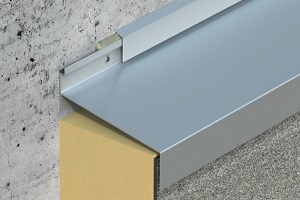 Buildings contain a variety of built-in tools to maintain their long-term structural integrity. Flawless, well-designed construction projects hide these elements to prevent interference with the facility’s aesthetic appeal. However, out of sight can also mean out of mind. As a building owner or operator, you may forget or neglect to check your building’s structural components until damage has already occurred.
Buildings contain a variety of built-in tools to maintain their long-term structural integrity. Flawless, well-designed construction projects hide these elements to prevent interference with the facility’s aesthetic appeal. However, out of sight can also mean out of mind. As a building owner or operator, you may forget or neglect to check your building’s structural components until damage has already occurred.
Through wall flashing is a perfect example of a frequently overlooked structural component. In order to protect the structural integrity of your building, it is necessary to learn what through-wall flashings are, where in your building you can find through-wall flashings, and how to evaluate the condition of through-wall flashings for regular maintenance.
Understanding Through Wall Flashing
The term through-wall flashing, commonly abbreviated as TWF, refers to a type of flashing that is installed inside (not outside) of a building’s wall. Through wall flashings are often made of metal. Metal is ideal for flashings because it enables them to wick water away from a building and prevent mold development or other moisture-related damage.
Without through-wall flashings, buildings made from absorbent materials like brick may experience water pooling along porous surfaces. This can damage walls if it is not promptly repaired. Through wall flashing is an essential building component that acts as a barrier against external water and moisture sources.
Most through-wall flashing extends from a wall wythe’s innermost face to its exterior face. A “wythe” refers to a section of brick or stone that is one row deep. Through wall flashing can be found in other building sections, and understanding how to locate it will depend upon industry standards as well as your building’s particular design. If you have access to the building’s original schematics, this can help expedite the process, but it is not necessary if you use a professional expert or examine the building exterior with care.
Where You Can Find Through Wall Flashing
You can find your building’s through-wall flashing by starting at a few locations that are known to contain flashings. Most wall flashings are discoverable in the same reliable locations of every building, with some exceptions. Finding your building’s through flashing will take time and careful inspection. Windows are one of the most likely through-wall flashing locations.
Try examining the area to the immediate left or right of the window, as well as above and below. Pay attention to the walls that intersect your roof. Walls that sit above an intersection roofline (either sloped or straight) often contain through-wall flashings to assist with the removal of water. However, an expert can help you locate your flashing, no matter the type you may have.
Best Practices vs. Aesthetic Appeal
 Unfortunately, not all building improvements are seamless and sleek, and this tends to be true for through-wall flashings. Even skillfully installed through-wall flashings may still be noticeable to the naked eye. You can conceal flashings by using projecting flanges or drip edges, although you may find these options lacking in visual appeal.
Unfortunately, not all building improvements are seamless and sleek, and this tends to be true for through-wall flashings. Even skillfully installed through-wall flashings may still be noticeable to the naked eye. You can conceal flashings by using projecting flanges or drip edges, although you may find these options lacking in visual appeal.
Nevertheless, projecting flanges and drip edges still go mostly unnoticed and serve a vital role in assisting your building with waterproofing. Projecting flanges and drip edges’ visual shortcomings are nothing compared to the eyesore that is deteriorated masonry, mold and algae spread, or even bulging and buckling walls.
Why You Should Regularly Evaluate Your Flashings
Flashings are critical for the long-term fitness of your building. If water seeps into your masonry, either through direct access or indirect capillary action from poorly installed flashings, your building’s interior walls and structural integrity could face severe damage.
From extensive mold growth to the dangers of cracked and bulging masonry requiring expensive repairs, water damage can destroy your building while showing almost no visible evidence until it has advanced to a severe stage. Some of the damage caused by water can pose a risk to your own health and safety: the development of hazardous black mold or the sudden collapse of brickwork. Checking your flashings should become part of your routine maintenance plan so that you can verify if they have loosened or separated from the exterior wall.
Trust The Experts To Help You Keep Your Building Dry
You don’t have to address your building’s repair and maintenance tasks on your own; the experts can take care of it for you. The professionals at Waterproof Caulking & Restoration would be happy to help you understand proper building flashing maintenance, regardless of what type of through-wall flashing you have. Reach out today to learn more about our services or to schedule an appointment and get started.
